sailors
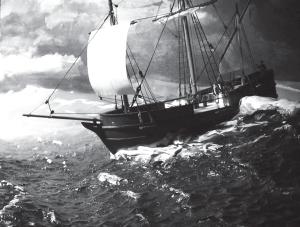 The dangers of the Cape Cod shoals are well known to the seamen who regularly navigate those waters. Almost from the time the shoals were discovered, they have been wreaking havoc on the ships that have the misfortune of getting too close to them. Sailors know that they need to steer clear of the Cape coast. Thousands of ships have been destroyed on its bars and rocks, and with the lost ships, uncounted lives too have been lost in the storm-tossed waves. When the storms were raging and a ship got caught, there was no way for rescuers to get to the trapped crew and passengers. The storms battered the trapped ships until they sank.
The dangers of the Cape Cod shoals are well known to the seamen who regularly navigate those waters. Almost from the time the shoals were discovered, they have been wreaking havoc on the ships that have the misfortune of getting too close to them. Sailors know that they need to steer clear of the Cape coast. Thousands of ships have been destroyed on its bars and rocks, and with the lost ships, uncounted lives too have been lost in the storm-tossed waves. When the storms were raging and a ship got caught, there was no way for rescuers to get to the trapped crew and passengers. The storms battered the trapped ships until they sank.
Oddly, Cape Cod is both a hazard and a haven to the mariners. All shipping between Boston and New York must either pass into its sheltered bay or run aground on its treacherous shoals. It is only the skill of the mariners that determines the difference. The shoals, when combined with the forces of 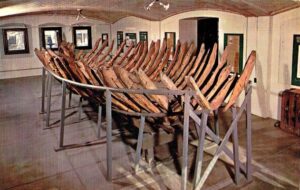 countless Nor’easters put the Cape in a precarious location. Because of this, the Cape has been the site of more than 3,000 shipwrecks in 300 years of recorded history.
countless Nor’easters put the Cape in a precarious location. Because of this, the Cape has been the site of more than 3,000 shipwrecks in 300 years of recorded history.
One of the first recorded wrecks was that of the Sparrow Hawk. The Sparrow Hawk originally hailed from London, England. It was making a six-week voyage to Virginia when it ran aground off Nauset Harbor in 1626. A gale arose and forced the vessel over the bar into the harbor. The ship ran aground near Orleans. The area isn’t always so dangerous. When the tide is low, people aboard the ships were able to get ashore safely when their ships ran aground. When Sparrow Hawk grounded, some English-speaking Indians arrived and offered to conduct them to Plymouth or carry a message. Grateful, they accepted and once ashore, they sent a message which brought Governor William Bradford with repair material. The ship was soon repaired, but before it could set sail, the ship was sunk by another storm. The sunken ship was abandoned.

The second wreck would be more permanent, as the ship wasn’t seen for over 200 years. The wreckage reappeared on May 6, 1863, after the sand shifted. The exposed remains of the ship reappeared only briefly. Because of the vessel’s unusual shape, two local men made a drawing of it. The ship was an oddity, and it drew many visitors. The visitors, when they came to see, nearly all took a fragment of the ship for a souvenir before it was again covered by sand in August of 1863. Since they now knew where the ship was, it has since been excavated, and the ribs of the ship were removed and transferred to the Pilgrim Hall Museum in Plymouth, where it is to this day.
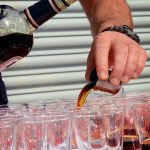 There are some traditions or practices that, upon further consideration, are not necessarily good traditions or practices. Between 1850 and as recently as 1970, sailors on Royal Navy Ships were given a daily rum ration, which was also called a tot, at midday every day. The amount of alcohol it contained was about 1/8 of a pint of rum at 95.5 proof. The practice was discontinued in 1970 because it was thought that regular intakes of alcohol would lead to unsteady hands when working machinery. Senior ratings of petty officer and above received their rum neat, while it was diluted with two parts of water, known a grog, to make 3/8 of an imperial pint for junior ranks. The rum ration was served from one particular barrel, which was ornately decorated and was made of oak and reinforced with brass bands with brass letters saying “The Queen, God Bless Her.” It was known as the “Rum Tub.”
There are some traditions or practices that, upon further consideration, are not necessarily good traditions or practices. Between 1850 and as recently as 1970, sailors on Royal Navy Ships were given a daily rum ration, which was also called a tot, at midday every day. The amount of alcohol it contained was about 1/8 of a pint of rum at 95.5 proof. The practice was discontinued in 1970 because it was thought that regular intakes of alcohol would lead to unsteady hands when working machinery. Senior ratings of petty officer and above received their rum neat, while it was diluted with two parts of water, known a grog, to make 3/8 of an imperial pint for junior ranks. The rum ration was served from one particular barrel, which was ornately decorated and was made of oak and reinforced with brass bands with brass letters saying “The Queen, God Bless Her.” It was known as the “Rum Tub.”
As is normal, there were some sailors who did not drink. So the question became, how would they be compensated. It was decided that these sailors would have a mark by their name of “T” for the Temperance movement. Sailors who opted to be “T” were given three pence, or about $1.00 a day instead of the rum ration. It is said that most of the men preferred the rum. The time when the rum ration was distributed was called “Up Spirits,” which was between 11 am and 12 noon. A common cry from the sailors was “Stand fast the Holy Ghost.” This was in response to the bosun’s call “Up Spirits.” Each mess had a “Rum Bosun” who would collect the rum from the officer responsible for measuring the right number of tots for each mess. The officers did not get a rum ration. Another strange tradition associated with rum rations is that the Tot glasses were kept separate from any other glasses. This was because they were washed on the outside, but never inside, in the belief that residue of past tots would stick to the side of the glass and make the tot even stronger. I would consider that to be really gross, but I’m not a sailor. Sailors under 20 were not permitted a rum ration, and were marked on the ship’s books as “UA” (Under Age).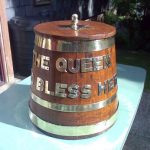
A sailor’s ration of alcohol was originally beer. At that time, a daily ration of one gallon was given. This official allowance continued until after the Napoleonic Wars. When beer was not available, as often happened due to spoilage, it could be substituted by a pint of wine or half a pint of spirits depending on what was locally available. Later, the political influence of the West Indian planters led to rum being given the preference other spirits. The half pint of spirits was originally issued neat, or without water. It is said that sailors would “prove” its strength by checking that gunpowder doused with rum would still burn (thus verifying that rum was at least 57% ABV). I guess they didn’t trust the bar tender. “The practice of compulsorily diluting rum in the proportion of half a pint to one quart of water (1:4) was first introduced in the 1740s by Admiral Edward Vernon (known as Old Grog, because of his habitual grogram cloak). The ration was also split into two servings, one between 10 am and noon and the other between 4 and 6 pm. In 1756 Navy regulations required adding small quantities of lemon or lime juice to the ration, to prevent scurvy. The rum itself was often procured from distillers in Jamaica, Trinidad and Tobago and the British Virgin Islands. Rations were cut in half in 1823 and again in half, to the traditional amount, in 1850.”
In 1850, Parliament discussed the abolition of the rum ration, then again in 1881, but nothing came of it. In 1970, Admiral Peter Hill-Norton abolished the rum ration as he felt it could have led to sailors failing a breathalyzer test and being less capable to manage complex machinery. This decision to end the rum ration was taken after the Secretary of State for Defense had taken opinions from several ranks of the Navy. Ratings were instead allowed to purchase beer, and the amount allowed was determined, according to the MP David Owen, by the amount of space available for stowing the extra beer in ships. The last rum ration was on July 31, 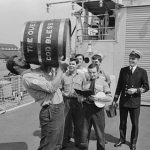 1970 and became known as Black Tot Day, because sailors were unhappy about the loss of the rum ration. There were reports that sailors threw tots into the sea and the staging of a mock funeral in a training camp. In place of the rum ration, sailors were allowed to buy three one-half imperial pint cans of beer a day and improved recreational facilities. While the rum ration was abolished, the order to “splice the mainbrace,” or awarding sailors an extra tot of rum for good service, remained as a command which could only be given by the Monarch and is still used to recognize good service. Rum rations are also given on special occasions. Examples include the 100th anniversary of the Canadian Royal Navy in 2010 and after the Queen’s Diamond Jubilee celebrations in 2012.
1970 and became known as Black Tot Day, because sailors were unhappy about the loss of the rum ration. There were reports that sailors threw tots into the sea and the staging of a mock funeral in a training camp. In place of the rum ration, sailors were allowed to buy three one-half imperial pint cans of beer a day and improved recreational facilities. While the rum ration was abolished, the order to “splice the mainbrace,” or awarding sailors an extra tot of rum for good service, remained as a command which could only be given by the Monarch and is still used to recognize good service. Rum rations are also given on special occasions. Examples include the 100th anniversary of the Canadian Royal Navy in 2010 and after the Queen’s Diamond Jubilee celebrations in 2012.

